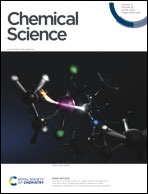Rational design of a promising oxychalcogenide infrared nonlinear optical crystal†
Abstract
Oxychalcogenides with the performance-advantages of both chalcogenides and oxides are emerging materials class for infrared (IR) nonlinear optical (NLO) crystals that can expand the wavelength of solid-state lasers to IR regions and are of importance in industrial and civil applications. But rationally designing a high-performance oxychalcogenide NLO crystal remains a great challenge. Herein, we chose the melilite-type Sr2ZnSi2O7 as the structure template. Through part isovalent substitution of S2− for O2− anions, the first hetero-anionic thiostannate Sr2ZnSn2OS6 with wide IR transmission has been synthesized. More importantly, compared to the maternal oxide, Sr2ZnSi2O7, the second harmonic generation (SHG) response of Sr2ZnSn2OS6 is enhanced by two orders of magnitude. In addition, Sr2ZnSn2OS6 can exhibit a large band-gap and high laser damage threshold. These advantages make Sr2ZnSn2OS6 a promising IR NLO crystal. Our research will provide insights into the rational design of new IR NLO crystals.



 Please wait while we load your content...
Please wait while we load your content...